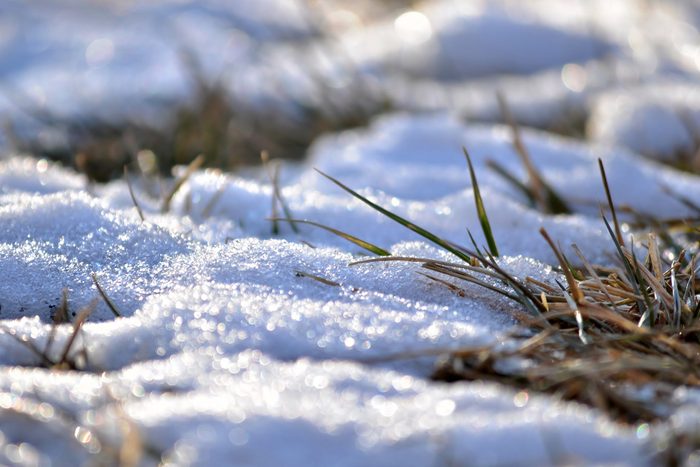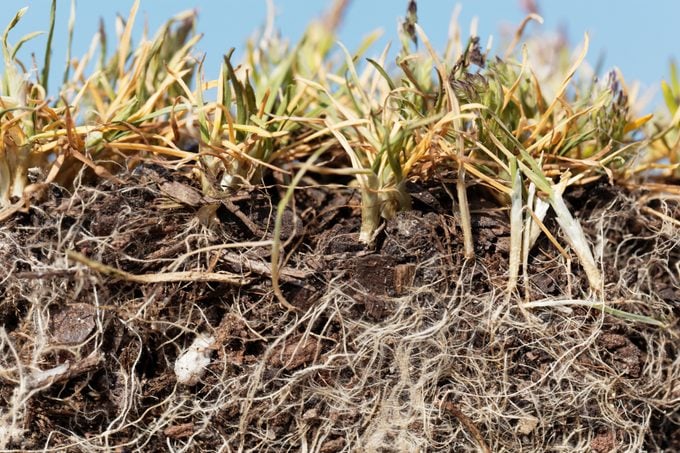Every editorial product is independently selected, though we may be compensated or receive an affiliate commission if you buy something through our links. Ratings and prices are accurate and items are in stock as of time of publication. 4U4ME/GETTY IMAGES
4U4ME/GETTY IMAGES
Not everything goes dormant in the wintertime. Winter weeds are thriving and will wreak havoc in your garden. Be sure you’re prepared.
Did you know that a single weed can produce 100,000 to 200,000 seeds that can survive in soil for 40 years, germinating every spring and fall without fail?
They’re more than a nuisance too. Weeds can cost the agricultural industry billions of dollars every year in lost crops, with billions more going toward the effort to get rid of them. For individual lawns and gardens, it might not be a billion dollar problem, but the weeds are the same.
Where Do Winter Weeds Typically Pop Up?
Winter weeds — undesired plants that germinate in the fall, grow and seed from winter into spring and then die off or go dormant as temperatures increase — can grow anywhere there’s soil. They especially like:
- Lawns, even more so if they are sparse and unhealthy.
- Areas where infestations have occurred in previous years,
- Regions with excessive rainfall,
- Gardens and lawns where equipment like lawn mowers and rototillers are regularly used. Both spread seeds.
How Do Winter Weeds Survive During Winter?
Plants earn the “weed” designation because of their extreme tenacity, thanks in part to a few built-in winter defense mechanisms.
Quiescence
This refers to a seed’s ability to wait in a vegetative state until their required growing conditions are met. Once that happens, it automatically triggers the growth cycle.
Dormancy
Dormancy takes quiescence and adds the biological instinct to successfully establish. In this case, achieving the required growing conditions doesn’t necessarily trigger continued development.
An extenuating condition within the seed itself can delay growth until its chances of surviving and establishing are at their best. It’s an astounding display of a complex biological process, and it makes dormancy by far the key to winter weeds’ survival.
Roots
Strong root systems help certain winter weeds survive harsh conditions. Dicot winter weeds have large taproots that make uprooting more difficult. These roots also sprout new growth if cut.
Perennials always have parts of their roots in the ground, storing up the energy they need to grow rapidly and aggressively. There are also some winter weeds that grow from rhizomes, notorious for their fast, lateral spread and their ease in sprouting new plants.
Types of Winter Weeds

Winter weeds are categorized based on their structure (broadleaf or grass) and life cycle (annual perennial, or biennial). These are important classifications because different life cycles and structures require different methods of control, especially with herbicides.
Many of the more widespread broadleaf winter weeds are also annuals. Stellaria media (common chickweed), Lamium amplexicaule (henbit), Lamium purpureum (purple deadnettle), Cardamine hirsuta (lamb’s cress) and Veronica arvensis (creeping Veronica) are the most widely seen examples.
Linaria vulgaris (wild snapdragon) is also a broadleaf winter weed, but unlike the examples above, it is a perennial. It also goes by toadflax or butter-and-eggs. Another well-known winter broadleaf perennial is Taraxacum officinale (dandelion).
The most well-known annual grass weed is Poa annua (annual bluegrass). Its hard-to-kill nature makes it a pervasive problem throughout the U.S.
How To Control Winter Weeds
- Apply safe, pre-emergent herbicide before winter weeds begin sprouting, to target the seeds and root systems of perennials.
- Spot treat or remove any weeds already visible.
- Fertilize.
- Apply mulch to starve seeds of nutrients from the sun and provide a growth barrier.
- Avoid non-targeted watering which benefits weeds too. Implement drip irrigation in garden beds so water is directly routed to plants.
- Limit digging and tilling which tend to spread seeds.
After implementing these preventative measures, inspect your garden regularly to discover weeds as early as possible. Remove or treat weeds the instant you notice them. Killing them before they drop seeds prevents infestations in years to come.
When treating sprouted weeds, you have two options.
Manual Removal
Weeds without deep roots or runners that grow in relatively contained patterns can be dug out by hand. All traces of the weed must be dug out, taking care to shake or disturb it as little as possible. You can do this with your hands, but a hand tool makes it much easier.
This stand-up weed removal tool is a good option. It’s easy to use and allows you to extricate the weed slowly and carefully, which is essential. I’ve always liked simple hand trowels with a serrated edge. Corona, which makes excellent hand tools, makes several hand weeders. I use their transplanter as a hand weeder and love how it works.
Herbicide Application
The best weed killer depends on the type of winter weed, the cultivated grass or plants being affected, and the climate. As some weeds develop resistance to certain treatments, it’s often more effective to alternate between two herbicides.
The Three Types of Herbicides
Chemical Herbicides
For broadleaf weeds, look for products with triclopyr, dicamba, MCPP or 2, 4-D. These are the active ingredients found in selective herbicides that kill broadleaf weeds but not your grass. Some products, called two-way and three-way herbicides, have two or more active ingredients.
Bonide makes a powerful option with triclopyr and dicamba. Another popular choice is a Fertilome product, which has 2, 4-D and dicamba.
Grass weeds present a bigger challenge because they can’t be treated with a herbicide without harming your cultivated lawn. If the lawn is completely dormant or you plan to re-sod, go for strong and non-selective herbicides, like those containing diquat (contact). Ortho’s GroundClear contains diquat and is also affordable.
All-Natural Herbicides
If you prefer all-natural herbicides, the most tried-and-true ingredients are vinegar and acetic acids, sodium chloride (salt), soaps, citric acid and essential oils. You can purchase products already mixed or products that require adding water. You also can mix your own recipes at home.
Most all-natural or organic herbicides are non-selective and will damage or kill anything they come in contact with. All-natural selective herbicides are harder to find, but out there.
A vinegar-based non-selective that works well is Natural Element’s Weed Killer. OrganicMatters proprietary blend of vinegar, sodium chloride, clove oil, lemon juice, sodium lauryl sulfate and water is another tried-and-true all-natural non-selective.
Reduced-Risk Herbicides
Thanks to green chemistry and innovations, there’s a third option: reduced-risk herbicides with active ingredients like mesotrione and imazamox.
I’ve always liked Tenacity and regularly recommend it. Tenacity was granted a reduced-risk status by the EPA because it uses mesotrione as the active ingredient. While it’s toxic to many kinds of weeds, there are no cancer-causing ingredients, and it’s been deemed safe to use on lawns where children and pets play.
Visit FamilyHandyman.com for more articles like this. Reprinted from FamilyHandyman.com, © 2022 Home service Publications Inc. , Webster, Maria 10/20/2022
